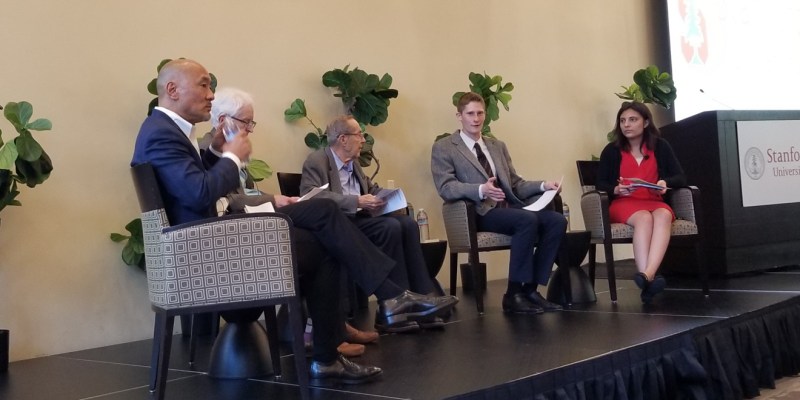On Friday, former Secretary of Defense William J. Perry was joined by former Director of Los Alamos National Laboratory Siegfried Hecker and Ploughshares Fund chief operating officer Philip Yun for a conversation on nuclear threat in the 21st century. The symposium, organized by Stanford Nonproliferation Activism Project (SNAP), emphasized disarmament and nonproliferation, a movement whose objective is to prevent the global spread of nuclear weapons.
SNAP is a student-led group founded last year by Jonah Glick-Unterman ’20, class president and research assistant at the William J. Perry Project. For its first event, SNAP worked in conversation with the non-governmental organization Nuclear Threat Initiative (NTI) and the Department of State, and was co-sponsored by the Stanford Center for International Security and Cooperation (CISAC), the Management Science & Engineering department (MS&E) and the Stanford Speakers Bureau (SSB).
According to its website, SNAP’s goal is to raise the Stanford community’s awareness on issues of nuclear security and to educate the student body on nuclear nonproliferation activism. To this end, SNAP conducted a survey of Stanford students last spring quarter to gauge interest on issues of nuclear threats. Glick-Unterman introduced the talk by recounting some of the survey responses, stating that 43 percent of students answered affirmatively when asked if they felt the Stanford community was directly threatened by nuclear weapons.
“When asked how students can engage with nuclear nonproliferation and disarmament, responses focused on the importance of destigmatizing the conversation around nuclear weapons into one that is incorporated into education and discussion outside of the walls of the White House,” he added.
Why nuclear security still matters today
The speakers first addressed the question of why nuclear weapons are still important today and how the challenges of nuclear security are different than those of the Cold War. Yun noted the false ballistic missile alert that was issued in January 2018 to television, radio and phones in Hawaii. The alert stated that a ballistic missile threat was inbound to the state.
“So for 30 minutes [before the residents were advised of the error], I had some friends in Hawaii who were stunned as to what that meant and what they could do,” Yun said. “[In that situation] the President would have, I believe, something like 10 minutes to decide whether to respond to launch no missiles, to launch one missile or to launch 1,000 missiles that could roam the world all over.”
Yun specifically mentioned the danger of nuclear tension due to North Korea and Supreme Leader Kim Jong Un’s penchant for aggressiveness and surprise, despite talks between President Donald Trump and Kim Jong Un this past June, during which both leaders affirmed North Korea’s commitment to “work toward complete denuclearization of the Korean peninsula.”
Taking a different approach, Hecker, who is currently a senior fellow at the Freeman Spogli Institute (FSI) and a professor in the MS&E department, addressed the question by drawing from his experience as Director at Los Alamos National Laboratory, which was secretly established during World War II to facilitate the design of nuclear weapons. It has since expanded to conduct multidisciplinary research in national security, medicine, technology and computing.
“From a scientist’s perspective, it’s very simple: the bomb,” Hecker said. “When you fuse the nuclei … you’re talking about energy [by] a factor of millions. And that doesn’t go away, just because we’re in 2018.”
The danger of a false alarm
Hecker emphasized that the sheer magnitude of a potential nuclear attack, combined with the declining number of individuals in the world who have hands-on knowledge and experience with nuclear weapons, is the greatest challenge in international security today.
“My greatest concern is actually the accidental detonation of the nuclear device or the inadvertent use of the nuclear weapon because of a lack of appreciation [for the severity] from the policymakers’ standpoint,” Hecker said.
Perry, who is a senior fellow at the FSI and the Hoover Institution, stated that, during the Cold War, there were five false alarms, two of which he experienced personally during his time as United States Secretary of Defense. He also addressed the false alert in Hawaii that Yun had described earlier.
“I would describe it is a blundering,” Perry said. “Blundering into nuclear war. And that’s all too likely a possibility.”
He reiterated that miscalculations could be the reason for a large-scale nuclear conflict. According to Perry, even a one percent possibility of a nuclear mistake is too likely to tolerate, when considering the severity of the consequences.
What students can do
All three speakers emphasized the importance of educating people, especially students, on the issue of nuclear weapons. Perry in particular stressed the importance of supporting and reading material from organizations working toward disarmament, such as the NTI.
“It makes a moral and ethical statement,” Perry said, referencing the Treaty on the Prohibition of Nuclear Weapons (TPNW), adopted by a United Nations conference in 2017, “and I support it for that reason. It’s a moral and ethical statement that needed to be made, has been made and has been supported by 120 countries — it’s a powerful statement.”
According to Perry, there cannot be viable political action towards the goals of nonproliferation until the population becomes educated on the issues, and the education has to be built from the ground up. As a way to address this concern, Perry and Hecker continue to teach courses at Stanford on international security and nuclear threats.
“The first thing is to educate … students on the issue. If you don’t understand, if you don’t know what to do, then you don’t know what to recommend [to policymakers],” Perry said. “The first thing is to educate yourself.”
Contact Elena Shao at eshao98 ‘at’ stanford.edu.
